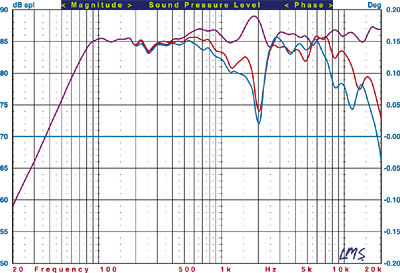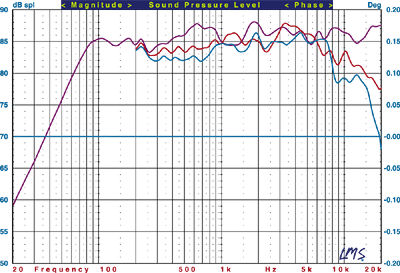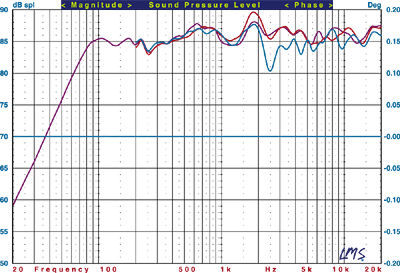NHT Evolution T6 Tower surround speaker system Measurements
The NHT M6 was measured by itself, without the B6 subwoofer. Its sealed cabinet is tuned to approximately 63Hz, and its useful bass extension (-10dB) extends to approximately 50Hz. Its minimum impedance is 4.3ohms at 110Hz; our measurements suggest a nominal impedance of 6ohms, with a relatively benign phase. The M6's sensitivity measured about 86dB/W/m; it should not be a difficult load to drive.
The M6's pseudo-anechoic response at tweeter height, positioned vertically, averaged over a 30° forward horizontal angle and combined with the nearfield responses of the woofers, is shown in Figs. 1a and 1b (violet). The response is respectably smooth and flat for a speaker at this price, the only notable deviations being a small rise in the upper midrange centered at about 700Hz, and a sharper peak in the low treble at about 1.8kHz. Neither caused any obvious problems in the listening tests, though they might have contributed to some of the slight coloration I occasionally heard on dialogue.

Fig.1a: NHT M6, vertical orientation, pseudo-anechoic horizontal response at 45° (red) and 60° (blue) on tweeter side.

Fig.1b: NHT M6, vertical orientation, pseudo-anechoic horizontal response at 45° (red) and 60° (blue) on midrange side.
Fig.1a also shows the response changes as we move horizontally off-axis in the direction of the tweeter (toward the center position between the speakers when they're set up as recommended, with the tweeters facing in). Fig.1b shows the changes as we move off-axis horizontally on the midrange side. It appears from these figures that NHT hasn't completely reached their goal of flat response on the tweeter side (toward the listener) and a dip on the midrange side (toward the room's sidewalls). But if we look at the 15° off-axis results (Fig.2), we can see that the response on the tweeter side stays relatively close to the on-axis average, while the response on the midrange side begins to show a suckout near the midrange/tweeter crossover region—as NHT intended. These curves also suggest that if the left and right speakers are aimed straight ahead, as recommended, a listener positioned in the center "sweet spot" and significantly off the speakers' front axes will not hear the flattest response from the M6s'. Therefore, even for a single listener, I recommend enough toe-in to keep the listening chair positioned no more than 15-20° off the horizontal axis. When the M6 is positioned vertically, its off-axis response response remains consistent within a +/-15° vertical window. Within this range, the height of the listener's ears will be noncritical.

Fig.2: NHT M6, vertical orientation, pseudo-anechoic horizontal response at 15° off-axis on tweeter side (red), 15° off-axis on midrange side (blue).
We then turned the M6 sideways, as it most likely would be when used as a center-channel speaker, and got the curves in Fig.3. The averaged forward response is approximately as before (as in the vertical orientation shown in Figs. 1a and 1b—allowing for small changes likely due to different reflection patterns from the reoriented cabinet). In this position, the horizontal off-axis response will be the same on either side. Not unexpectedly, and by design, the off-axis response in this position is considerably smoother than with the speaker upended, even apart from the expected off-axis high-frequency rolloff.

Fig.3: NHT M6, horizontal orientation, pseudo-anechoic horizontal response at 45° (red) and 60° (blue).
In the horizontal configuration the +/-15° vertical response now becomes essentially the same as the horizontal response in Fig.2. That is, if you set up the M6 horizontally with the tweeter at the top—the intuitive arrangement—you'll get a response dip as you move down toward the midrange. This suggests that mounting the speaker with the tweeter at the bottom might be beneficial if you place it atop a tall rear-projection TV. Finally, the M6's measured on-axis responses with its grille first on, then off, were virtually identical. With the boundary switch in the "1" position, the bass output at 100Hz was reduced by about 3dB.—TJN
Note: All figures: Violet: pseudo-anechoic response on tweeter axis, averaged across 30° horizontal window, combined with nearfield response of woofers.
- Log in or register to post comments




































































